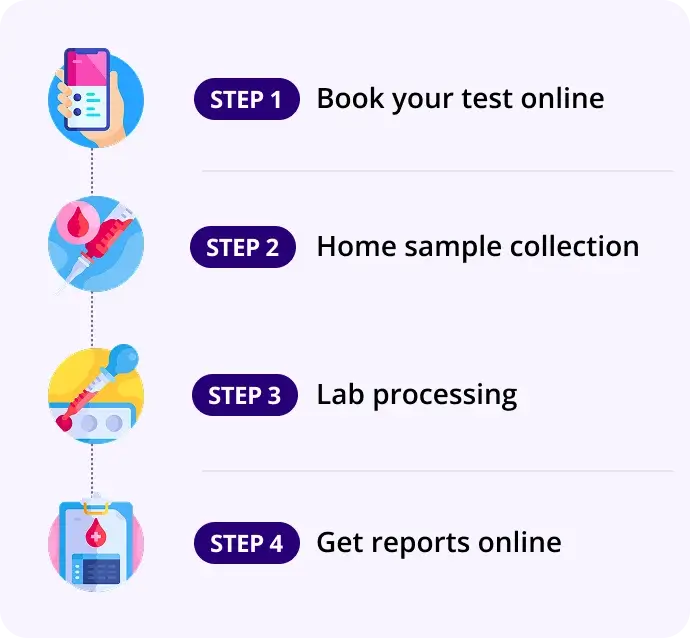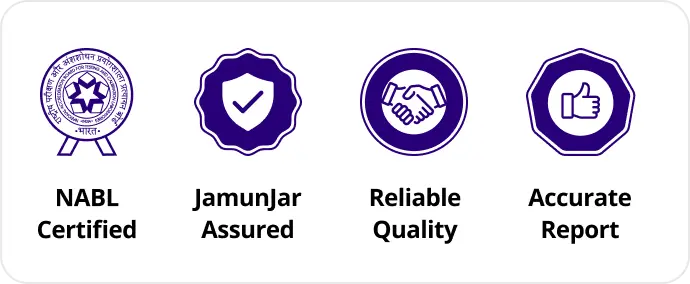Haptoglobin Serum
Report in 60Hrs
At Home
No Fasting Required
Details
Commonly used to assess hemolytic anemia
₹2310₹2900
20% OFF
🧪 What is Haptoglobin?
Haptoglobin is a plasma protein produced by the liver that binds to free hemoglobin released from red blood cells (RBCs) during hemolysis.
This prevents iron loss and kidney damage and helps recycle hemoglobin.
The serum haptoglobin test measures the level of this protein in the blood and is commonly used to assess hemolytic anemia.
❓ Why is the Haptoglobin Test Done?
To:
- Detect or monitor hemolytic anemia
- Differentiate hemolytic anemia from other types of anemia
- Assess intravascular hemolysis (RBC breakdown within blood vessels)
- Evaluate liver function (since haptoglobin is synthesized in the liver)
📊 Normal Range
Test | Normal Range |
|---|---|
Haptoglobin (Serum) | 30 – 200 mg/dL (may vary slightly by lab) |
Reference ranges may vary depending on age, gender, and the lab method used.
📈 Interpretation of Results
Result | Clinical Significance |
|---|---|
Low Haptoglobin (< 30 mg/dL) | Suggests intravascular hemolysis (free hemoglobin binds haptoglobin and is cleared) |
Normal Haptoglobin | No active intravascular hemolysis or other cause for increased destruction |
High Haptoglobin (> 200 mg/dL) | May occur in inflammation, infection, trauma, or nephrotic syndrome (acute phase reactant) |
🔍 In extravascular hemolysis (in spleen/liver), haptoglobin may remain normal or mildly decreased.
🧠 Associated Organs & Conditions
Organ | Associated Conditions |
|---|---|
Red Blood Cells | - Hemolytic anemia (autoimmune, G6PD deficiency, sickle cell, mechanical valves) |
Liver | - Decreased synthesis in liver disease or cirrhosis |
Kidneys | - Free hemoglobin can damage nephrons if not bound to haptoglobin |
Immune System | - Autoimmune hemolytic anemia (AIHA) lowers haptoglobin levels significantly |
🔄 Related / Follow-Up Tests
- Reticulocyte Count – To assess bone marrow response
- Lactate Dehydrogenase (LDH) – Elevated in hemolysis
- Indirect Bilirubin – Increased in hemolytic anemia
- Peripheral Smear – Look for schistocytes, spherocytes
- Direct Coombs Test (DAT) – For autoimmune hemolysis
- Serum Free Hemoglobin – Elevated in intravascular hemolysis
✅ Fasting Required?
Test | Requirement |
|---|---|
Serum Haptoglobin | ❌ No fasting required – Blood can be drawn any time |
📝 Summary Table
Parameter | Details |
|---|---|
What | Blood test measuring haptoglobin, a protein that binds free hemoglobin |
Why | Detect or monitor hemolytic anemia, assess liver function |
Normal Range | 30 – 200 mg/dL |
Low Levels | Indicates intravascular hemolysis (RBC destruction) |
High Levels | Non-specific; may rise in inflammation or tissue injury |
Follow-up Tests | Reticulocyte count, LDH, bilirubin, Coombs test |
Fasting Required | ❌ No |
How our test process works!

